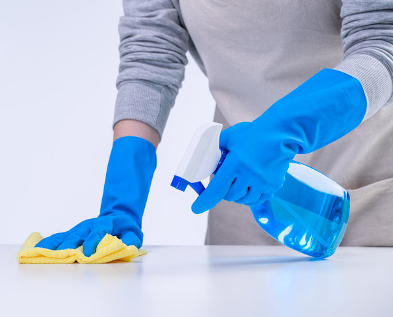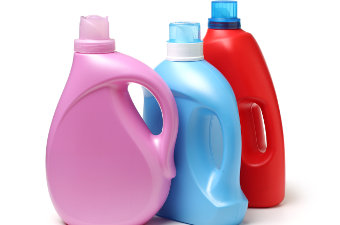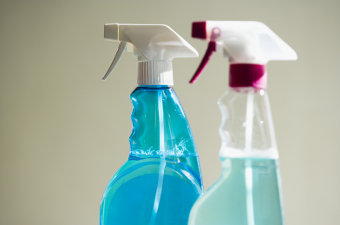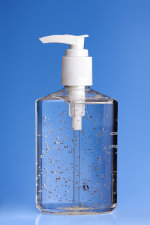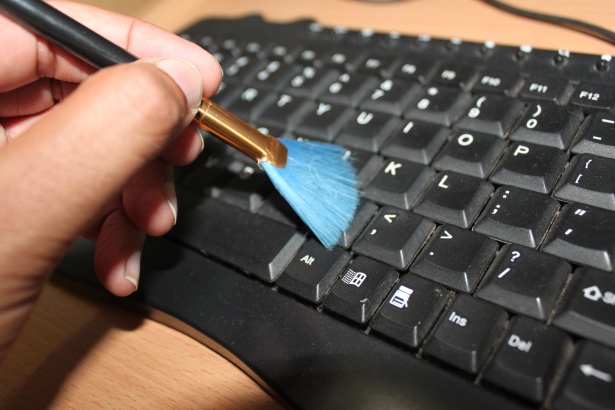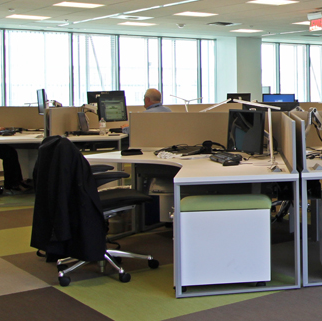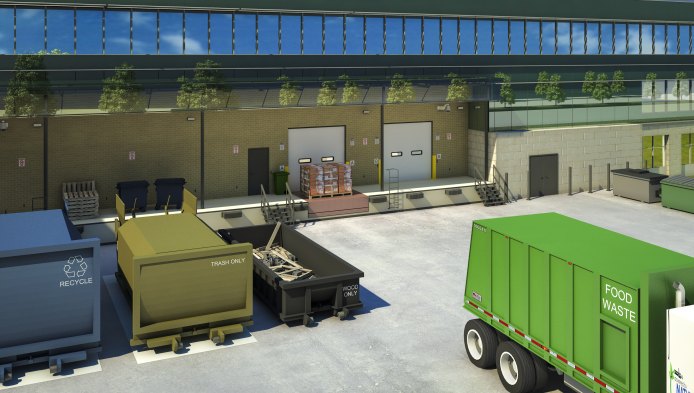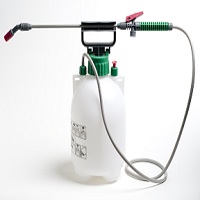Healthy Cleaning
Note: The information, content, and data found in this module don’t represent GSA or any other federal agency-specific policies, practices, specifications, or contracts. This module should not be viewed as, nor considered an endorsement of, the types of custodial services that are available or offered by the Government. This module is a broad-based collection of various industry practices performed by custodial contractors, building maintenance personnel, or occupants that may not apply to any or all facilities.
Why is Healthy Cleaning Important?
The primary goal of this module is to promote the positive impacts of implementing a healthy cleaning program. If you have not heard of the term “healthy cleaning” before, you are not alone!
In the development of this module, a team of experts in a variety of different fields came together to collaborate and compile relevant information that will help an organization develop a cleaning program that successfully accomplishes the main goal of cleaning (reducing pathogens, dirt, and impurities from surfaces or objects), and does so in a manner that promotes the health of building occupants, visitors, and cleaning staff as well as provides the organization many of the positive environmental and life cycle benefits that have been proven effective in various green cleaning programs.
Explore this page to implement healthy cleaning programs that promote employee, contractor, and visitor health, improve indoor air quality for occupants, and support a sustainable interaction with the environment.
What is Cleaning?
Choose the least hazardous cleaning product that meets efficacy requirements
Cleaning reduces pathogens, dirt, and impurities on surfaces or objects. Cleaning works by using products containing soap or detergent with water to physically remove pathogens and impurities from surfaces. This process does not necessarily kill pathogens, but by removing them, it lowers their numbers and the risk of spreading.1
Cleaning reduces pathogens on surfaces by removing contaminants and decreases the risk of infection from surfaces. When there are no confirmed or suspected sources of biological hazards in a space, cleaning using soap or detergent once a day is usually enough to reduce contaminants that may be on surfaces and help maintain a healthy facility. However, there are times when a more thorough cleaning process is needed (e.g., restrooms, food preparation areas, confirmed exposures, healthcare facilities, and a variety of other situations). In these cases, cleaning and disinfecting surfaces is an important, two-step process. The first step is to clean the area by using soap and water to remove pathogens, dirt, and impurities from surfaces. This lowers the risk of spreading infection. The second step would be using a disinfectant product to kill pathogens on surfaces. A key part in the process is to allow the disinfectant product to remain wet on the surface per the manufacturer's recommendations to allow sufficient time to kill the pathogen(s) of interest, often referred to as contact or dwell time. Once sufficient time has passed, the surfaces should be wiped dry. This process will reduce the risk of spreading pathogens as, without disinfection, they may remain viable (living) for hours to days on surfaces depending on the pathogen and type of materials exposed. By killing pathogens on a surface after cleaning, it can further lower the risk of spreading infection. Disinfecting does not necessarily clean dirty surfaces or remove pathogens, but by killing pathogens that remain on a surface after cleaning, disinfecting can further lower the risk of spreading infection.2,3
There is often a lot of confusion between sanitizers and disinfectants. Sanitizers and disinfectants are two types of antimicrobial pesticides. An antimicrobial pesticide is a substance or mixture used to destroy or suppress the growth of harmful microorganisms such as bacteria, viruses, or fungi on inanimate objects and surfaces.
Sanitizers reduce, but not necessarily eliminate, bacteria from surfaces to levels considered safe as determined by public health codes or regulations. These are often used in food preparation areas or in other products (e.g., air sanitizers, carpet sanitizers, etc.) They are not intended to kill viruses.
Alternatively, disinfectants destroy or irreversibly inactivate infectious viruses and bacteria on surfaces. As discussed above, disinfectants are often used in healthcare facilities or other areas where biological hazards are present. However, overuse of these products can lead to adverse environmental or health impacts.
4Cleaning products also have impacts on human health and safety as well as the environment throughout their
lifecycle. Cleaning products can impact the material being cleaned, such as reducing durability particularly for wood, metals, stone, historic finishes, and fine art. Ensuring proper dilution is also an important step to not damaging materials.
The application of cleaning products near historic finishes and fine art must be done with great care so as not to damage surfaces or materials through overspray or other means. Please contact a professional restoration company or fine art experts with any questions before applying cleaning products near historic finishes or fine art. For more information, see the guidance on
Cleaning Surfaces from the GSA’s Sustainable Response to COVID-19 Task Group. Due to all of the potential adverse impacts, employers should choose the least hazardous
cleaning product that still meets their efficacy requirements.
5Efficacy is the ability of a cleaning or disinfectant product to produce the desired effect. This is often related to the ability to reduce or eliminate the risk of exposure to specific biological hazards. The EPA maintains a
registry of all pesticides (including disinfectant products) that can be accessed to ensure that manufacturer claims are true, including efficacy claims.
Health and Safety Impacts
Health hazards associated with the use of cleaning and disinfectant products will vary greatly depending on the toxicity of the chemical, duration of exposure (i.e., how long), concentration (i.e., how much chemical is involved), and route (e.g., dermal contact, ingestion, and inhalation) of exposure. These risks can range from skin irritation to serious health concerns, and in some cases death.
The most common negative health impact is that chemicals in some cleaning products can be irritating to the skin or can cause rashes. Cleaning products that contain corrosive chemicals can cause severe burns if splashed on the skin or in the eyes. Mists, vapors, and/or gases from cleaning chemicals can irritate the eyes, nose, throat, and lungs. Symptoms may include burning eyes, sore throat, coughing, trouble breathing, and wheezing. Chemicals in some cleaning products can contribute to an increased risk of new-onset asthma or trigger asthma attacks. Some cleaning products contain hazardous chemicals that enter the body through skin contact or from breathing gases into the lungs. As an example, mixing cleaning products that contain bleach and ammonia can cause severe lung damage or possible death. In general, disinfectants and sanitizers are more hazardous than cleaners. Although their degrees of toxicity vary, all products should be used with the proper safety precautions, follow manufacturer recommendations, and be used only for the intended purposes. Toxicity can be acute or chronic—acute toxicity refers to adverse health effects from exposure to a chemical once or within a short time, while chronic toxicity refers to adverse health effects from repeated exposure to a chemical over time.
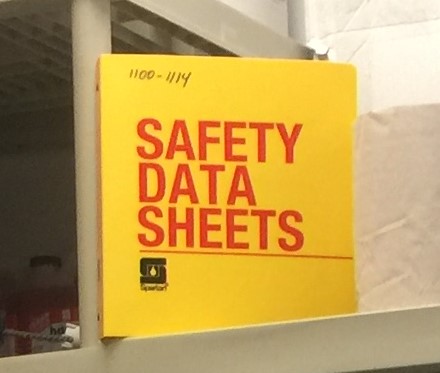
Employers are responsible for informing their employees about the chemical hazards in the workplace and implementing appropriate control measures to protect employee health and safety. Employers must develop policies to protect and train their employees before assigning cleaning and disinfecting tasks by:
3,5,6
- Ensuring employees are properly trained to read labels on the hazards of the cleaning and disinfecting chemicals used in the workplace according to OSHA’s Hazard Communication standard (29 CFR 1910.1200). The OSHA Hazard Communication Standard requires manufacturers and importers of hazardous chemicals to develop Safety Data Sheets (SDS) for each chemical or mixture of chemicals. Employees need to be able to understand the information that is contained in these documents.
- Protecting their employees from hazardous chemicals, by providing personal protective equipment (PPE), as well as training on when to use the PPE; what PPE is necessary (refer to SDS for specific cleaning and disinfection products); how to properly put on, use, and take off PPE; and how to properly dispose of PPE.
Environmental Impacts
Many employers and building managers are purchasing “green” cleaning chemicals with the expectation that green cleaning products are safer for workers and the environment. The intent of these alternative choices in products is typically to improve indoor air quality, reduce the health risks to employees, and reduce the amount of PPE that the employer is responsible for purchasing. However, the word “green” in a name or on a bottle does not ensure that a chemical is safe or environmentally friendly. Employers should review the labeling and SDS for the cleaning chemicals they purchase, including green cleaning products, to understand their lifecycle impacts and choose the least hazardous cleaning product that still meets their requirements.5
Cleaning affects water use and quality, indoor air quality, energy usage, solid waste management (including hazardous, medical, and municipal), and human health ‒ both indirectly and directly.
| Indirect | Direct |
| Wastewater (e.g., sewage) Treatment Plants: On average, water treatment plants have a lifespan of fifty years and treatment equipment last 15-20 years. Due to the age of the equipment and volume of water, the treatment process may not remove all micro-fibers and extract chemicals (e.g., pharmaceuticals, detergents, solvents, etc.) which result in corrosion of the infrastructure (i.e., pipeline and equipment). For more information:
|
Water used during cleaning (diluting, washing), manufacturing process, or irrigating: The earth has an abundance of water, but unfortunately, only a small percentage (about 0.3 percent), is accessible for manufacturing, irrigation, or human personal use. The other 99.7 percent is in the oceans, soils, icecaps, and floating in the atmosphere. Still, much of the 0.3% that is usable is unattainable.7
Action: Conserve water while still ensuring chemicals are properly diluted and appropriate amounts of freshwater are available for rinsing. |
Microplastics: Microfiber is synthetic cloth made of plastic. When washed, the “lint” that isn't captured in the clothes dryer is carried off to the wastewater treatment plant. Since they are “micro”, most treatment procedures are unable to filter this plastic and is then transported to rivers and oceans for aquatic, wildlife, and humans to consume.8
Action: Minimize the use of plastics |
|
| Indirect | Direct |
Manufacturing: Energy used during the manufacturing of cleaning products (e.g. mops, bottles, rags, chemicals)
Action: Purchase from companies that use renewable energy during manufacturing |
Equipment: Energy consumed by appliances and equipment used during cleaning and washing including use of hot water.
Actions:
- It’s important to use ENERGY STAR certified appliances and equipment to conserve energy and decrease GHGs.
- Plug loads: Unplug cleaning equipment when not in use to conserve energy.
|
Disposal: Energy used to dispose of one-time use cleaning products
Action: Use washable or reusable items |
|
| Wastewater treatment plants: Plants require energy to process cleaning wastewater |
|
| Indirect | Direct |
| Action:
|
Landfill: The increased use of one-time use cloths, gloves, and masks are filling landfills at an alarming rate.
Action:
- Purchase items that are reusable, refillable, and/or washable to decrease the amount of waste generated and associated GHG emissions. Purchase only the amount needed, to avoid overstocking unused products that may later be discarded.
- Purchase items based on packaging
 (i.e., paper, plastic, amount of) to decrease materials in the waste stream (i.e., paper, plastic, amount of) to decrease materials in the waste stream
- Use natural fibers (e.g., cotton and wool) that can be composted at the end of use
|
|
Hazardous materials and waste: Cleaning cloths, mops, or brushes used during painting, certain cleanings, or construction projects can be considered Hazardous Materials and should be disposed of according to federal and state regulations. |
|
Universal Waste: Batteries, light bulbs, or electrical equipment used during cleaning. According to RCRA , these items should be recycled. , these items should be recycled. |
|
Medical sharps: Properly dispose of sharps in a building’s health clinic. If there is not one, bins should be installed in restrooms where needed.
|
|
Aerosols: Cleaning products in aerosol cans are flammable and not accepted in most recycling programs |
| Indirect | Direct |
| Water pollution: Pollutants in water that were not extracted during the wastewater treatment process, which are now in rivers, lakes, and drinking water |
Inhalation: Inhalation of cleaning products can contribute to respiratory irritation for the operator as well as the persons in close proximity to where the cleaning took place. |
| Air pollution: Pollutants in the air from the use of aerosols or exhaust (e.g., manufacturing, buildings, motorized equipment) |
Skin irritation: An acute and chronic concern when using cleaning products that are not properly diluted |
|
Ingestion: Use of cleaning and disinfecting products in aerosol cans emits particles in the air which can be ingested by the operator or those nearby. Use a pump spray instead to maximize cleaning product to land on the surface. |
Click the green dots below to learn more:
Policies and Plans
Federal Guidelines and Standards
The EPA maintains a registry of all pesticides (including disinfectant products) that can be accessed to ensure that manufacturer claims are true. EPA reviews pesticide product labels as part of the licensing/registration process and approves all label language before a pesticide can be sold or distributed in the United States. The overall intent of the label is to provide clear directions for effective product performance while minimizing risks to human health and the environment. In addition, the efficacy of the product is verified so you can determine if the product can control the specific pathogen of concern.9
The National Institute of Allergy and Infectious Diseases defines emerging infectious diseases/pathogens as those “that have newly appeared in a population or have existed but are rapidly increasing in incidence or geographic range.” Many of the emerging pathogens of greatest concern are pathogenic viruses. How long these viruses last on surfaces can play a role in disease transmission. SARS-CoV-2, the coronavirus that causes COVID-19, is an example of a pathogenic virus. Because the occurrence of emerging viral pathogens is less common and less predictable than established pathogens, few if any EPA-registered disinfectant product
as those “that have newly appeared in a population or have existed but are rapidly increasing in incidence or geographic range.” Many of the emerging pathogens of greatest concern are pathogenic viruses. How long these viruses last on surfaces can play a role in disease transmission. SARS-CoV-2, the coronavirus that causes COVID-19, is an example of a pathogenic virus. Because the occurrence of emerging viral pathogens is less common and less predictable than established pathogens, few if any EPA-registered disinfectant product labels specify use against this category of infectious agents. A company can apply for an emerging viral pathogen claim, even before an outbreak occurs, based on previous EPA-approved claims for harder-to-kill viruses. EPA reviews the supporting information and determines if the claim is acceptable. Once approved, a company can make certain off-label claims as specified in that guidance in the event of an outbreak such as SARS-CoV-2 (COVID-19) early in the pandemic.
labels specify use against this category of infectious agents. A company can apply for an emerging viral pathogen claim, even before an outbreak occurs, based on previous EPA-approved claims for harder-to-kill viruses. EPA reviews the supporting information and determines if the claim is acceptable. Once approved, a company can make certain off-label claims as specified in that guidance in the event of an outbreak such as SARS-CoV-2 (COVID-19) early in the pandemic.
When there is a novel (new) type of pathogen that has not been sufficiently researched, the EPA and CDC use the Spaulding Hierarchy Model to establish efficacy against emerging pathogens, such as SARS-CoV-2 early in the pandemic. If a product has a claim against a “harder to kill” small non-enveloped virus, then a product is expected to be effective against an “easier to kill” enveloped virus such as SARS-CoV-2, the virus responsible for COVID-19. The exact emerging pathogen disinfectant guideline taken directly from the EPA and CDC is as follows:10
“Viral Subgroup Classification: EPA and the Centers for Disease Control and Prevention (CDC) recognize that certain microorganisms can be ranked with respect to their tolerance to chemical disinfectants. The Spaulding Classification model, used by CDC, tiers microorganisms in accordance with the level of resistance to being killed (inactivation) by typical disinfectant products. With this approach viruses are divided into three viral subgroups (small non-enveloped, large nonenveloped, and enveloped) based on their relative resistance to inactivation. According to this hierarchy, if an antimicrobial product can kill a small, non-enveloped virus it should be able to kill any large, non-enveloped virus or any enveloped virus such as the current SARS-CoV-2. Similarly, a product that can kill a large, non-enveloped virus should be able to kill any enveloped virus."
Procurement Requirements
- First develop a list of your healthy cleaning needs.11
- Areas to be cleaned
- Levels of service
- Equipment to be used (specified by custodial contractor)
- Personal Protection Equipment
- Cleaning product associated with the cleaning area
- Cleaning process (specified by custodial contractor)
- Cleaning schedule
- Seasonal or rare cleaning actions like mud being tracked in from a storm or bird droppings
- Any education or training on how to use equipment and cleaning product
- Identify who is responsible for procuring the equipment and cleaning products and where to purchase from
- Relate healthy cleaning requirements to a company policy, federal, state, or municipal statute or law, which will support the procurement process
- Conduct Market Research on the cleaning equipment and products you Identified. This will help identify cost, vendors, shipping options, bulk purchasing, and proper storage of items.
- You may need to decide if you want to procure needed items from one vendor or multiple vendors.
- Your procurement requirements may change due to changes in tenants, weather, company mission, or other considerations.
- If there are tenants in the building, include healthy cleaning requirements in their lease agreement and provide a procurement example.
- Educate tenants on disposing of hazardous waste. For the federal government, dumpsters are the responsibility of the building owner.
- For GSA leases, refer to GSA’s Leasing Sustainability Policies
 . GSA leasing requirements cover several cleaning-related topics, including janitorial services, cleaning products, paper products, recycling, construction waste management, and pest management.
. GSA leasing requirements cover several cleaning-related topics, including janitorial services, cleaning products, paper products, recycling, construction waste management, and pest management.
Health and Safety
Hazard Communication Plan
Each employee needs to be made aware of possible hazards that they might be exposed to while conducting cleaning. Employers are responsible for developing a hazard communication plan per the OSHA requirements in 29 CFR 1910.1200. The plan will list all chemical products proposed to be used and include current Safety Data Sheets (SDS) for each product. The plan should include documentation of training for all employees in the plan and the hazard communication standard. The plan should also identify the method of labeling the employer will use for all chemical product containers, including secondary dispensing containers used on site. The standard requires the employer to maintain a copy of their written hazard communication plan on-site and it must be readily available to employees.
Exposure Control Plan
Employers should establish and implement an exposure control plan (ECP) to protect staff, building occupants and visitors from contamination, illness or injury by bacteria, viruses, other infectious agents, or potential chemical hazards found in existing building materials encountered during custodial tasks. The ECP is a written document that specifies the processes and procedures to be used when working with or around materials that have health risks. The ECP is a living document that may change depending on changes in staff or building conditions.
- Whether the employer proposes to use staff or subcontract support to perform cleaning of biological materials or waste in various circumstances including, but not limited to the following:
- Blood on any surface
- Blood, vomit, or feces in restrooms
- Blood or vomit on carpet surfaces
- Flooding that includes sewage
- Animal, pigeon, and other avian excrements outside the building
- Minor flooding or drain water backups that may contain blackwater (water from toilets and bathrooms that likely contain feces and/or urine)
- Used medical sharps
- Documentation of training in the OSHA bloodborne pathogens act (29 CFR 1910.1030) and CDC guidelines for any staff designated to perform the cleaning.
- A list of the personal protective equipment to be used by staff in performing cleaning and disposal of biological materials or waste.
- A description of the procedures to be followed by staff when encountering blood, vomit, sewage, or excrement in the course of their duties.
- Procedures for cleaning up black water or grey water (i.e., Category 2 or 3) and describe how impacted building materials should be handled per ANSI/IICRC S-500 Standard and Reference for Professional Water Damage Restoration or equivalent.
- A description of the procedures to be followed by staff when encountering mold in the course of their duties, per ANSI/IICSC S-520 Mold Remediation, the EPA Mold Remediation in Schools and Commercial Buildings, or equivalent.
- A list of hazardous materials that could be encountered during custodial activities, such as:
- Lead exposure - Lead is found in many surface coatings that a person conducting cleaning might come into contact with. In facilities where this is likely (e.g., built pre-1978, have an indoor firing range, have tenants that carry/clean guns, contain garages or hobby spaces where lead could be used), OSHA 29 CFR 1910.1025 should be followed. To inform workers about this potential hazard, employers need to ensure that employees receive at least lead awareness training. Be especially careful in cleaning any areas that are known to accumulate lead (e.g., any areas that use or store weapons or ammunition, inside ductwork, hobby garages, etc.)
- Asbestos exposure - In buildings where asbestos-containing materials are present, under OSHA 29 CFR 1910.1001, employers must provide their employees with annual asbestos awareness training. One specific material that is encountered frequently during cleaning activities is flooring material that contains asbestos. When cleaning flooring that may contain asbestos, such as vinyl tile, use the National Institute of Building Sciences (NIBS) Guidance Manual, ‘Asbestos Operations and Maintenance Work Practices’. You should never burnish or use dry stripping methods on asbestos-containing flooring.
- Specific work procedures and prohibited practices while working with these materials.
Pandemic Plans
To safeguard employees and provide for continued operations in the event of a pandemic, it is recommended that employers prepare a pandemic plan. This will help prevent and reduce the spread and mitigate the potential effects of a pandemic on custodial and related services. Given the unpredictable length and severity of a pandemic, the plan should link planned actions to the periods and phases established by the World Health Organization for a pandemic cycle and to the guidance provided by CDC.
The pandemic plan should:
- Identify key personnel and their credentials for such an event
- Require and provide employees with appropriate training to fully address cleaning requirements during pandemic events
- Explain how staff will communicate with each other and clients
- Provide a contingency (backup personnel)
 to continue services if staff get sick and are unable to work
to continue services if staff get sick and are unable to work
- Identify those procedures that ensure timely, effective, and safe disinfectant cleaning practices
- Specify the type of control measures that will be used including engineering (e.g., ventilation), administrative, and personal protective equipment (e.g., gloves, respiratory protection, coveralls, etc.)
- Provide protocols to ensure that the Contractor has sufficient supplies of cleaners, PPE, and disinfectants
References:
Fall Protection Requirements
Cleaning of building exterior surfaces, including windows, and any work on elevaated surfaces such as ladders, steps, or balconies, present a potential safety hazard for custodial workers. Building owners are required to perform workplace assessments and may be required to prepare fall protection plans and implement fall protection practices to ensure the safety of the custodial workers.
- Fall Protection - The procedures and equipment used to protect personnel from the hazards of a fall from an unprotected edge. This is an overall term that encompasses all of the subcategories below and is often used interchangeably.
- Fall Arrest - Equipment used to stop progression of a fall after it has occurred. For example, fall arrest equipment could include a body harness and shock-absorbing lanyard connected to a certified rooftop anchor with a tied-off rope.
- Fall Restraint - Individual equipment provisions used to prevent a worker from reaching an unprotected edge.
- Fall Prevention - Systems or processes used to prevent a worker from coming within a defined distance from an unprotected edge. This could include stanchions and a warning line or use of a second person to act as a continuous monitor.
- Edge Protection - Railing or parapet at the edge of an elevated level. Also includes covers over holes/skylights.
- Unprotected Edge - Any edge of a walking/working surface (floor, roof, ramp, etc.) where there is no protection against falling over the edge. Typically defined where the fall is at least 4 or 6 feet and any guardrail/wall is less than 42 inches.

Specific fall protection requirements are dependent on many factors including the height of the building, whether workers will suspend off the building, and whether the edge is unprotected or not. A key relevant regulation is OSHA 1910 Subparts D, F, and I. Other relevant regulations and standards include OSHA 1926, ANSI Z359 standards , International Window Cleaning Association I14
, International Window Cleaning Association I14 , and local jurisdiction requirements, such as California General Requirements for All Window Cleaning Operations. In general, when custodial workers utilize suspended maintenance equipment (such as a rope descent system or scaffolding system), building owners should ensure anchor systems are appropriate for intended use, inspected, certified (e.g. load tested) regularly in accordance with all requirements. Building roof anchor systems intended for the support of window washing devices should be a permanent part of the structure and should be sound, rigid, and capable of supporting the maximum intended loading without displacement or deformation. (Reference 29 CFR 1910.28(a)(2) and 1910.28(a)(26).) In addition, the suspended maintenance systems themselves need to meet the requirements in 29 CFR part 1926, subpart L.
, and local jurisdiction requirements, such as California General Requirements for All Window Cleaning Operations. In general, when custodial workers utilize suspended maintenance equipment (such as a rope descent system or scaffolding system), building owners should ensure anchor systems are appropriate for intended use, inspected, certified (e.g. load tested) regularly in accordance with all requirements. Building roof anchor systems intended for the support of window washing devices should be a permanent part of the structure and should be sound, rigid, and capable of supporting the maximum intended loading without displacement or deformation. (Reference 29 CFR 1910.28(a)(2) and 1910.28(a)(26).) In addition, the suspended maintenance systems themselves need to meet the requirements in 29 CFR part 1926, subpart L.
Healthy Cleaning Plans
A Healthy Cleaning plan should include the following sections:
- Purpose
- Scope
- Goals
- Standard Operating Procedures (SOPs)
- General Cleaning Process relating to but not limited to: dusting, mopping, dry floor cleaning, chemical/product handling, washing rags for reuse, and solid waste management.
- Safety Manual
- Procurement Requirements
- Equipment and product list
- List of appropriate PPE for each cleaning process
- Risk Management relating to spills, leaks, or mismanagement of equipment and products
- Environmentally preferred cleaning products
- Cleaning Products and Equipment Specifications
- Training
- Responsible parties
- Occupant or tenant and public or guest to building involvement
- The time period of cleaning
- Auditing and Quality Assurance
- Worker Safety and Health
For an example, see the Northern Arizona State University’s Green Cleaning Policy .
.
A cleaning plan should also address procedures for non-standard operations. For example, when a building is closed for a long duration (more than 5 days), custodial staff should flush toilets once a day and pump soap to decrease the growth of bacteria.
When first implementing a Healthy Cleaning Plan, consider developing a Change Management Plan to address the accompanying operational and cultural changes.
Best Practices
Integrative Design
A successful Healthy Cleaning program utilizes an Integrative Design Process, which includes a multidisciplinary group of stakeholders from conceptualization through operations. The group extends beyond the custodial team to include facilities management personnel, procurement professionals, and occupants. Occupant involvement provides transparency and facilitates the collection of occupant concerns. An integrative team can also clearly define responsibilities, such as whether occupants should clean their personal desks.
What is Best for your Space
When and How Often?
Regular or routine cleaning is conducted on a frequent basis to maintain a safe and healthy environment. High-traffic spaces and high-touch surfaces are prioritized and cleaned at least once daily. Routine cleaning may be scheduled for off hours but is normally performed during the day; day cleaning can save energy.
Deep cleaning should be conducted once or twice a year in common areas to target discrete and concealed locations. Deep cleaning services are often solicited by tenants moving into a new space, or alternatively when a tenant is moving out. Deep cleaning can be labor and time intensive. It is best to schedule deep cleaning projects during off hours at an office to limit the facility disruptions.
Typically, common or public areas such as lobbies or kitchens and shared spaces like conference rooms or hoteling desks will experience higher levels of traffic compared to personal desks. Shared working areas should be targeted for more frequent cleaning, whereas a personal space that is used by one person can reasonably be cleaned on a less frequent basis. Special custodial access and cleaning schedules may be required for unique spaces, such as laboratories.
Integrating touch-free surfaces can help decrease the amount of daily cleaning that needs to be done in common areas. Automatic sensors can eliminate the need for tenants to touch door handles or light switches, which in turn would mean these surfaces would be cleaned during less frequent deep cleans of windows or hard furniture surfaces. Automatic sensors on bathroom facilities such as toilets, sinks, or hand dryers may not eliminate the need to clean these areas on a regular basis but can help decrease tenants’ or customers' exposure to otherwise dirty, high-traffic surfaces.
UV lighting
Ultraviolet (UV) light has been used in the industry for many years to kill or inactivate microorganisms. The efficacy of this technology can vary greatly depending on many variables including the microorganism of concern, intensity of the light source, contact time, air movement, temperature, and relative humidity. In many facilities such as those owned and operated by GSA, this type of technology is often used in air handling units to help control microbial growth on cooling coils and drain pans.
Additionally, it has been used in hospitals and other facilities with a high risk of pathogen transmission (e.g., waiting rooms, shelters, prisons, etc.) where the UV lights are wall-mounted high in the room with light directed horizontally across the upper level of the room where disinfection occurs. These products often work well because they have been professionally designed and installed taking into consideration all the variables listed above. GSA does not currently recommend this type of application in their facilities. There have also been a variety of different products that have been marketed for use in cleaning & disinfection applications. When using mobile products, you need to understand how each of those variables impacts the efficacy of the product and realize that there are likely significant limitations due to the inability to control certain factors. In addition, there needs to be a great deal of caution employed if you are considering using any of these products as UV light is a form of non-ionizing radiation that can cause serious health effects to the user or others nearby including skin and eye damage. Additionally, UV light can damage surfaces and fixtures. Based on these risk factors, GSA does not currently recommend or use these types of products in their facilities for cleaning and disinfection.12
Ultrastatic Sprayers and Foggers
There are key differences between foggers and electrostatic sprayers:
Typically, these devices are placed on the ground and emit a chemical product in a semi-spherical shape that will theoretically distribute a chemical evenly on surfaces within an effective radius (~10 - 20 ft.) where there is an unobstructed view.
Applied by a person holding or wearing a machine and spray positively charged chemical droplets directionally onto surfaces. These droplets are attracted to surfaces so it helps with an even distribution of the product.
These products can be effective at disinfecting large spaces in a quick amount of time. However, they can also cause damage to tenant owned equipment due to overspray and can cause indoor air quality (IAQ) issues. The IAQ issues are caused due to chemicals that linger in the air after application.
Please note that foggers and electrostatic sprayers are designed to be specifically used with one or a group of chemical products. The electrostatic sprayer that someone buys from a local box store or online cannot be used with any disinfectant product. If the disinfectant product can be used in one of these machines, it will be noted in the EPA pesticide registry information for that disinfectant product.
If these products are used, proper personal protective equipment (PPE) should be worn and sufficient time should be allowed after each application for any chemicals to dissipate. Based on the specific product, often any food products in the area should be disposed of and any food or drink containers (e.g., cups, plates, bowls, etc.) should be cleaned prior to use.
Bottom line, there are certain cases where it might be a cost-effective mitigation measure if done properly. Each case is different where the risks to tenants and property will need to be weighed against the cost benefits. Additionally, the use of these devices does not replace the cleaning aspect of the process and only impacts the disinfection portion. All impacted surfaces must be cleaned before disinfectant application.13
Contracting
Custodial Contracts
Monitoring Performance
It is important to monitor the performance of your cleaning program to ensure it is meeting your standard of care and you are achieving the results you intend. Standards can help you define and measure performance.
- APPA Levels of Service: APPA is an association for educational facilities leadership, and they have developed defined levels of service for cleaning, maintenance, and grounds. The cleaning levels of service are referenced in the US Green Building Councils’ (USGBC) Leadership in Energy and Environmental Design (LEED) for Operations and Maintenance
 standard as a way to measure the performance of your green cleaning program. The levels range from Level 1 to Level 5 and describe the cleaning outcome you wish to achieve such as in Level 1 Orderly Spotlessness – “Floors and base moldings shine and/or are bright and clean”. On their own, the levels can be used to measure the effectiveness of cleaning procedures. Are the procedures and products producing the cleanliness results you wish to achieve? However, these guidelines can be utilized most effectively with service level agreements between customers and providers. A scope of work can identify the custodial level of service required for each space which can then be measured by the customer or contracting representative.
standard as a way to measure the performance of your green cleaning program. The levels range from Level 1 to Level 5 and describe the cleaning outcome you wish to achieve such as in Level 1 Orderly Spotlessness – “Floors and base moldings shine and/or are bright and clean”. On their own, the levels can be used to measure the effectiveness of cleaning procedures. Are the procedures and products producing the cleanliness results you wish to achieve? However, these guidelines can be utilized most effectively with service level agreements between customers and providers. A scope of work can identify the custodial level of service required for each space which can then be measured by the customer or contracting representative.
- The Cleaning Industry Management Standard (CIMS 3000)
 : This standard is a certification for your entire cleaning program. It is a management standard that looks at many aspects of the program including quality, service delivery, human resources (including hiring and training), health, safety, environmental stewardship, and management commitment. It also includes an optional green building component that was developed based on the USGBC LEED requirements. The standard is not prescriptive and focuses on quality and customer satisfaction.
: This standard is a certification for your entire cleaning program. It is a management standard that looks at many aspects of the program including quality, service delivery, human resources (including hiring and training), health, safety, environmental stewardship, and management commitment. It also includes an optional green building component that was developed based on the USGBC LEED requirements. The standard is not prescriptive and focuses on quality and customer satisfaction.
Another benefit of using these standards and guidelines is to determine staffing levels and workload planning. Both the APPA levels of service and the CIMS information allow you to determine how many people are needed to get the desired level of service or cleanliness levels. This is beneficial to determine in-house staff as well as understanding staffing and costs of contractors.
Performance-based contracting focuses on the purpose of work performed and the outcome to be achieved, rather than the prescriptive manner in which the work is done. The International Facility Management Association defines a performance-based contract as one that "contains quantitative or qualitative indicators (performance measures) used to assess a provider's performance against a specified level of performance of an output or outcome (performance standard)."
When thinking about custodial service contracts, for example, a prescriptive contract may require cleaning to be performed in a space three times each week. In this example, the expectation is that three times per week will be sufficient to achieve the desired outcome, however, the desired outcome is not stated. Performance-based contracting instead focuses on the desired outcome such as a level of cleanliness to be achieved as measured against a known standard. An example would be to require the space to be cleaned to achieve APPA Service Level 2: Ordinary Tidiness; in this case, the APPA standard sets the expectation for what "clean" should be like.
Cleaning Theater
"Cleaning theater", sometimes called "hygiene theater" refers to the implementation of cleaning activities to give the impression of improved conditions without actually reducing the risk of contaminant exposure the cleaning is supposed to target. According to the CDC , cleaning surfaces as we normally would using soap or detergent is sufficient since the risk of respiratory disease transmission is primarily through close contact via aerosolized droplets.
, cleaning surfaces as we normally would using soap or detergent is sufficient since the risk of respiratory disease transmission is primarily through close contact via aerosolized droplets.
One reason is it can make people feel safe: something is being done, and that something is different from what is perceived as "normal". Somewhat similar, from an organizational perspective, it looks good and makes the performer feel like they are doing something even if it isn't effective.
If it makes people feel safe, isn't that better? Not exactly. From a facilities budgeting perspective, it can be a waste of time and resources that could be better used elsewhere. From a people perspective, it can promote a sense of reduced risk that can cause us to be less attentive to activities that do matter such as washing one's hands regularly, monitoring and working to improve overall indoor air quality, ensuring adequate ventilation is provided and cleaning appropriately.
Cleaning theater is a quick fix to a perception problem, but it can lead to a false sense of security. Instead of engaging in theater, work through the key elements of a cleaning program. Consider the following:
- What needs to be cleaned
- Where, if at all, is disinfection needed
- How often should cleaning be conducted
- What products should be used
- What resources are needed (people, equipment, PPE)
- What training is needed (use of products, equipment, PPE)
Quality Assurance
The ISO 9000 family of quality management systems defines quality assurance as "part of quality management focused on providing confidence that quality requirements will be fulfilled". In relation to a custodial contract, the quality assurance process ensures you are receiving the services or outcomes desired or required in the contract and is part of monitoring the performance of the contractor or in-house personnel.
It is best practice for both the Custodial Contractor and the Building Owner's Representative to establish a written plan for Quality Control/Quality Assurance at the beginning of any engagement.
- Document QC/QA Inspections
- Include detailed remarks
- Document both satisfactory and unsatisfactory performance
- Each inspection should include a sampling of the building; this may mean sampling areas that were not sampled on previous inspections.
- Inspect areas of high concern (health unit, food service, labs, child care, etc.) more frequently
- Include high traffic and high visibility areas (lobbies, waiting areas, restrooms, etc.).
- Inspect areas that are problematic in the building more frequently.
- Inspect all aspects of the custodial contract, including grounds/landscaping, pest control, window cleaning and washing, snow and ice removal, etc.
- Inspect dumpsters before they are hauled to verify the use of one-time cleaning materials
- Consider periodic validation, beyond a visual inspection, using a hygiene monitoring system that provides a quantitative measurement of potential risk resulting from the presence of high levels of organic residues, including microorganisms (e.g., testing surfaces for Adenosine triphosphate (ATP))
- Best practice for Building Owner's Representative to occasionally perform joint inspections with the contract supervisor. This can be done as a part of recurring meetings with the contractor.
- For in-house cleaning staff, consider auditing consumable purchases and purchases of selected products to verify their use as expected.
- Anticipate change by documenting how the plan can be updated to adapt to new circumstances (e.g., building updates, occupancy changes)
Key Terms
- Cleaning - Cleaning removes pathogens, dirt, and impurities from surfaces or objects. Cleaning works by using soap (or detergent) and water to physically remove pathogens from surfaces. This process does not necessarily kill pathogens, but by removing them, it lowers their numbers and the risk of spreading infection.1
- Contact or dwell time - Time a disinfectant is in direct contact with the surface or item to be disinfected. This period is framed by the application to the surface for surface disinfection until complete drying has occurred. Depending on the disinfectant, this normally ranges from 1 minute to upwards of 10 - 15 minutes depending on the product and bacteria/virus.14
- Deep Cleaning - Additional cleaning of regularly cleaned surfaces (e.g., removing buildup regular cleaning doesn't get).
- Disinfecting - Disinfecting kills pathogens on surfaces or objects using chemicals. This process does not necessarily clean dirty surfaces or remove germs, but by killing germs on a surface after cleaning, it can further lower the risk of spreading infection.1,15
- Enhanced cleaning - As a result of specific concerns (e.g., during a pandemic, flu season, etc.), the frequency of routine cleaning is increased, and the addition of a disinfectant is added to help reduce the risk of transmission. This will entail cleaning/disinfecting the environment including frequently touched surfaces such as desks, countertops, doorknobs, computer keyboards, hands-on learning items, faucet handles, phones, and toys.16
- Pathogen - Organisms (e.g., bacteria, viruses, parasites, and fungi) that cause disease in human beings.
- Sanitizing - Sanitizing kills bacteria on surfaces or objects to lower the risk of spreading infection using chemicals. It is not intended to kill viruses.1,15
- Sustainable, green, eco-friendly, or environmental cleaning - Sustainable cleanings are processes and procedures used to clean that minimize harmful effects to the occupants of the built environment while also being able to use the cleaning tools and products for an indefinite time frame. The goal of sustainable cleaning is to negate negative effects on the built environment and its occupants.
- Volatile Organic Compounds (VOCs) - Carbon compounds that participate in atmospheric photochemical reactions (excluding carbon monoxide, carbon dioxide, carbonic acid, metallic carbides and carbonates, and ammonium carbonate). The compounds become a gas at normal room temperatures and degrade indoor air quality. VOCs can be found in paints, coatings, adhesives, sealants, and other finish materials.
Resources
Acknowledgements
- GSA Facilities Management Services Program
- GSA Public Buildings Service (PBS) Central Office
- GSA PBS Office of Facilities Management
- GSA PBS Region 5
- GSA PBS Region 7
- EPA Office of Pollution Prevention & Toxics
- APPA
- Fitwel
- ISSA
1 CDC | How to Clean and Disinfect Schools to Help Slow the Spread of Flu 2 EPA | EPA, CDC Release Guidance for Cleaning and Disinfecting spaces where Americans Live, Work, and Play
2 EPA | EPA, CDC Release Guidance for Cleaning and Disinfecting spaces where Americans Live, Work, and Play 3 CDC | Hazard Communication for Disinfectants Used Against Viruses
3 CDC | Hazard Communication for Disinfectants Used Against Viruses 4 EPA | What are Antimicrobial Pesticides?
4 EPA | What are Antimicrobial Pesticides? 5 OSHA | Protecting Workers Who Use Cleaning Chemicals
5 OSHA | Protecting Workers Who Use Cleaning Chemicals 6 Rutala, W.A., et al. (2008). Guideline for Disinfection and Sterilization in Healthcare Facilities
6 Rutala, W.A., et al. (2008). Guideline for Disinfection and Sterilization in Healthcare Facilities . CDC. 7 NGWA.org | Information on Earth's Water
. CDC. 7 NGWA.org | Information on Earth's Water 8 NOAA.gov | What are microplastics?
8 NOAA.gov | What are microplastics? 9 EPA | Pesticide Registration
9 EPA | Pesticide Registration 10 EPA | Guidance to Registrants: Process for Making Claims Against Emerging Viral Pathogens Not on EPA-Registered Disinfectant Labels
10 EPA | Guidance to Registrants: Process for Making Claims Against Emerging Viral Pathogens Not on EPA-Registered Disinfectant Labels 11 MyPMLLC.com | Free Project Management Templates
11 MyPMLLC.com | Free Project Management Templates 12 Taylor Engineering | COVID-19 White Paper
12 Taylor Engineering | COVID-19 White Paper 13 CDC | Safety Precautions When Using Electrostatic Sprayers, Foggers, Misters, or Vaporizers for Surface Disinfection During the COVID-19 Pandemic
13 CDC | Safety Precautions When Using Electrostatic Sprayers, Foggers, Misters, or Vaporizers for Surface Disinfection During the COVID-19 Pandemic 14 CDC (2008). Guideline for Disinfection and Sterilization in Healthcare Facilities - Glossary.
14 CDC (2008). Guideline for Disinfection and Sterilization in Healthcare Facilities - Glossary. 15 EPA | What’s the difference between products that disinfect, sanitize, and clean surfaces?
15 EPA | What’s the difference between products that disinfect, sanitize, and clean surfaces? 16 The Northern Ireland Regional Infection Prevention and Control Manual
16 The Northern Ireland Regional Infection Prevention and Control Manual
Related Topics
Cleaning Products
Institutional, industrial, and miscellaneous other cleaning products. Products in this category may also apply to the acquisition of custodial, cafeteria & food, construction, facilities operations & maintenance, and laundry services.
Cleanliness
Building cleanliness is both the process of removing dirt and contaminates from the building as well as the process of maintaining this state. Keeping the facility clean decreases the occurrence of “sick building syndrome” and uses less toxic chemicals in the process. Occupants are also more likely to express satisfaction and lose less productivity due to absenteeism in a well-cleaned building.
Green Cleaning
Cleaning removes pathogens, dirt, and impurities from surfaces or objects. Cleaning works by using soap (or detergent) and water to physically remove pathogens from surfaces. This process does not necessarily kill pathogens, but by removing them, it lowers their numbers and the risk of spreading infection.
Healthy, or sustainable, cleaning refers to processes and procedures that minimize harmful effects to the occupants of the built environment while also being able to use the cleaning tools and products for an indefinite time frame. The goal is to negate negative effects on the built environment and its occupants.
Visit SFTool's Healthy Cleaning page to learn more.
Healthy Buildings
Health, as defined by World Health Organization in its 1948 constitution, is “a state of complete physical, mental, and social well-being and not merely the absence of disease or infirmity”. This definition of health has been expanded in recent years to include (1) resilience and the ability to cope with health problems and (2) the capacity to return to an equilibrium state after health challenges.
These three health domains - physical, psychological, and social - are not mutually exclusive but rather interact to create a sense of health that changes over time and place. The challenge for building design and operations is to identify cost-effective ways to eliminate health risks while also providing positive physical, psychological, and social supports as well as coping resources.
Learn more about Buildings and Health.
 to continue services if staff get sick and are unable to work
to continue services if staff get sick and are unable to work (information on the phases of a pandemic cycle)
(information on the phases of a pandemic cycle)


![]() , International Window Cleaning Association I14
, International Window Cleaning Association I14![]() , and local jurisdiction requirements, such as California General Requirements for All Window Cleaning Operations. In general, when custodial workers utilize suspended maintenance equipment (such as a rope descent system or scaffolding system), building owners should ensure anchor systems are appropriate for intended use, inspected, certified (e.g. load tested) regularly in accordance with all requirements. Building roof anchor systems intended for the support of window washing devices should be a permanent part of the structure and should be sound, rigid, and capable of supporting the maximum intended loading without displacement or deformation. (Reference 29 CFR 1910.28(a)(2) and 1910.28(a)(26).) In addition, the suspended maintenance systems themselves need to meet the requirements in 29 CFR part 1926, subpart L.
, and local jurisdiction requirements, such as California General Requirements for All Window Cleaning Operations. In general, when custodial workers utilize suspended maintenance equipment (such as a rope descent system or scaffolding system), building owners should ensure anchor systems are appropriate for intended use, inspected, certified (e.g. load tested) regularly in accordance with all requirements. Building roof anchor systems intended for the support of window washing devices should be a permanent part of the structure and should be sound, rigid, and capable of supporting the maximum intended loading without displacement or deformation. (Reference 29 CFR 1910.28(a)(2) and 1910.28(a)(26).) In addition, the suspended maintenance systems themselves need to meet the requirements in 29 CFR part 1926, subpart L.![]() .
.![]() , cleaning surfaces as we normally would using soap or detergent is sufficient since the risk of respiratory disease transmission is primarily through close contact via aerosolized droplets.
, cleaning surfaces as we normally would using soap or detergent is sufficient since the risk of respiratory disease transmission is primarily through close contact via aerosolized droplets.





 and the Cleaning Management Institute
and the Cleaning Management Institute


